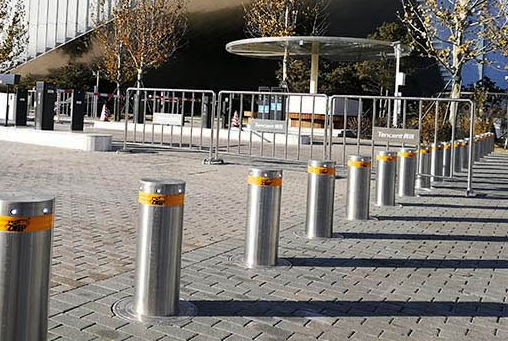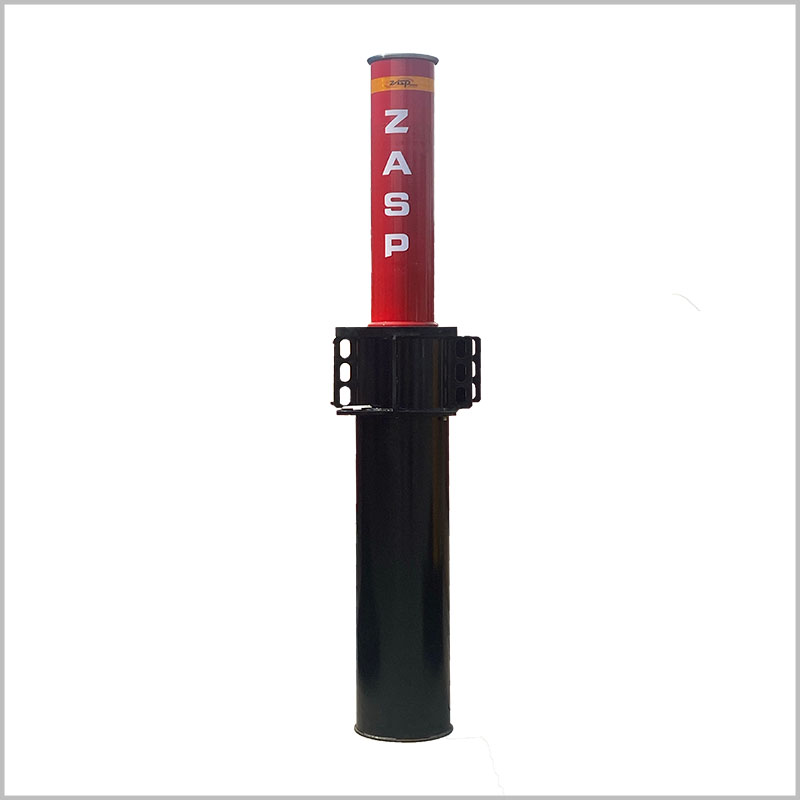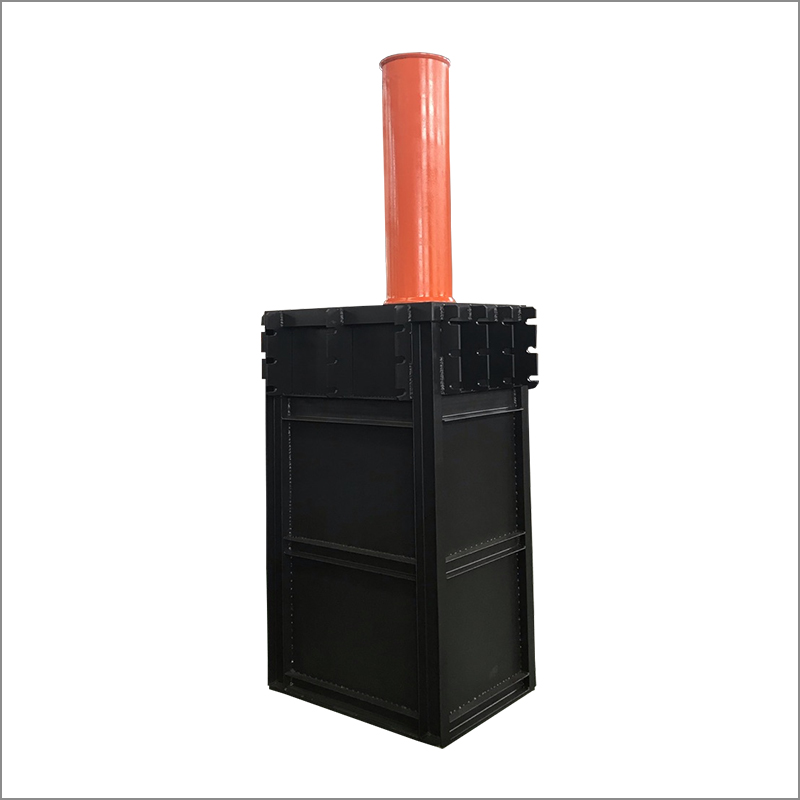In recent years, roadway environments have witnessed an alarming increase in vehicle-to-pedestrian incidents. These events pose significant threats to public safety, prompting cities around the world to explore effective solutions. Among the various safety measures, automatic bollards have emerged as a vital protective tool.
This post delves into the different categories of automatic bollards, their effectiveness in enhancing roadway safety, installation recommendations, and maintenance tips. By understanding the role of these devices, city planners and safety officials can better protect citizens and create safer roadway environments.
What is Hydraulic Bollards?
Automatic bollards are also known as hydraulic bollards and rising bollards, which serve not only to manage traffic but also to prevent unauthorized vehicle access to pedestrian-heavy areas.
Hydraulic bollards are engineered to rise and lower as needed, offering a dynamic solution for controlling access. Unlike fixed bollards, which remain stationary, hydraulic bollards can be retracted into the ground when access is permitted. This feature allows for greater flexibility, making them ideal for environments where vehicle access needs to be restricted at certain times but allowed at others.
Grades of Automatic Bollards
Automatic Rising bollards come in various grades, each designed for specific applications and levels of threat resistance. The classification primarily revolves around their ability to withstand impacts from vehicles of varying weights and speeds.
K4 M30 Automatic Bollards
Application Scenarios
K4 M30 automatic bollards are suitable for areas with moderate traffic, such as:
- Commercial Districts: Shopping centers and marketplaces where pedestrian traffic is high, and vehicle access must be controlled.
- Schools: Protecting students during school hours while allowing easy access for emergency vehicles.
- Parks and Recreational Areas: Ensuring pedestrian safety in spaces where vehicles may inadvertently enter.
Protection Capability
K4 M30 hydraulic bollards are engineered to withstand impacts from vehicles traveling at speeds of up to 30 mph (approximately 48 km/h). They can stop a vehicle weighing up to 15,000 pounds (about 6,800 kg). This level of protection is adequate for many roadway applications where the risk of high-speed collisions is minimal.
K12 M50 Automatic Bollards
Application Scenarios
K12 M50 automatic bollards are designed for high-risk environments such as:
- Government Buildings: Protecting sensitive areas from potential threats, including terrorism.
- Major Event Venues: Securing spaces during concerts, sporting events, and public gatherings where large crowds are present.
- Critical Infrastructure: Ensuring safety around power plants, data centers, and transportation hubs.
Protection Capability
K12 M50 bollards are built to resist impacts from vehicles traveling at speeds of up to 50 mph (approximately 80 km/h). They can stop vehicles weighing up to 15,000 pounds (about 6,800 kg) without being compromised. This makes them essential for locations where there is a significant potential for high-speed vehicular attacks.
Working Mechanism of Automatic Bollards
Understanding how automatic bollards operate is crucial for appreciating their role in roadway safety. The basic mechanism involves a hydraulic or pneumatic system that allows the bollard to rise and fall as needed.
Mechanical Structure
The main components of an automatic driveway bollard include:
- Bollard Body: Made from robust materials like steel, designed to withstand impacts.
- Hydraulic or Pneumatic System: This system controls the movement of the bollard. When activated, it raises the bollard to block vehicle access and lowers it to allow passage.
- Control Unit: This can be operated manually or automatically through sensors, remote controls, or integration with traffic management systems.
Integration with Other Safety Devices
Automatic retractable bollards can be enhanced by integrating with:
- Surveillance Cameras: Providing real-time monitoring of traffic and security.
- Access Control Systems: Allowing authorized vehicles to enter specific areas without manual intervention.
- Traffic Sensors: Adjusting bollard positions based on real-time traffic conditions.
This integration not only maximizes security but also streamlines traffic flow within roadway environments.
Effectiveness in Preventing Vehicle-to-Pedestrian Incidents
Case Studies
Numerous cities have adopted automatic bollards as part of their roadway safety strategy. For example:
London, UK: Implemented automatic bollards in pedestrian-heavy areas like Trafalgar Square. The result has been a significant decrease in vehicle-related incidents, enhancing the safety of thousands of pedestrians daily.

London UK
New York City, USA: Following several tragic incidents, NYC installed automatic bollards in Times Square, effectively reducing unauthorized vehicle access and protecting tourists and locals alike.

New York City USA
These case studies highlight the effectiveness of automatic bollards in real-world scenarios, demonstrating their potential to save lives.
Expert Opinions
Safety experts emphasize the importance of implementing automatic bollards as part of a comprehensive roadway safety strategy. Dr. Jane Smith, a leading roadway safety researcher, states, “The integration of automatic bollards in high-traffic pedestrian areas is a proactive measure that not only deters potential threats but also instills a sense of security among the public.”
Additionally, traffic management authorities recommend the use of automatic bollards as a means to control vehicle access while maintaining pedestrian flow, especially during peak hours.
Installation and Maintenance Recommendations
Installation Guidelines
To maximize the effectiveness of automatic bollards, consider the following installation recommendations:
- Location Selection: Install bollards at entry points to pedestrian zones, near schools, and around public event venues.
- Spacing: Ensure adequate spacing between bollards to allow for pedestrian movement while maintaining vehicle restrictions.
- Visibility: Bollards should be clearly visible, possibly with reflective surfaces or lighting, to enhance safety, especially at night.
Maintenance Best Practices
Regular maintenance is essential to ensure the longevity and functionality of automatic bollards. Recommended practices include:
- Routine Inspections: Conduct regular checks on the hydraulic or pneumatic systems, ensuring they are functioning properly.
- Cleaning: Keep bollards free from debris and dirt to maintain visibility and operational mechanisms.
- Prompt Repairs: Address any damage or malfunctions immediately to prevent safety risks.
Professional Bollards Manufacturer: ZASP
Beijing ZhuoAoShiPeng Technology Co., Ltd (ZASP) was established in 2009, which is a professional manufacturer of Hostile Vehicle Mitigation roadway safety barrier equipment, the R&D and the operation office is situated in Fengtai District of Beijing.
As HVM manufacturer, ZASP provide high security level products of Hydraulic Automatic Bollards, Road Blockers and Tyre Killers, also supply Semi-Automatic / Fixed / Removable / Manually Retractable bollards for different security level selected.
ZASP products are widely used in many locations across the Globe, such as Embassies, Airports, School locations, Government locations, Stadiums, Rail Stations, Banks, Energy Plants locations, Commercial sites, Private Residences and more.
Conclusion
Automatic bollards represent a vital component of hostile vehicle mitigation barriers and modern roadway safety strategies. By effectively managing vehicle access and preventing unauthorized entry into pedestrian-heavy areas, these devices significantly enhance public safety. As cities continue to face the challenges of increasing vehicular incidents, the adoption and implementation of automatic bollards will play a crucial role in safeguarding citizens.
City planners and safety officials are encouraged to consider the various categories of automatic retractable bollards, their operational mechanisms, and the proven effectiveness of these devices in real-world applications. By prioritizing public safety through innovative solutions like automatic driveway bollards, we can pave the way for safer roadway environments.
automatic bollards, hydraulic bollards, rising bollards, hostile vehicle mitigation barriers, ZASP HVM manufacturer, automatic driveway bollards,automatic retractable bollards




